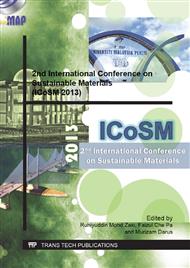p.128
p.133
p.137
p.141
p.148
p.153
p.158
p.164
p.170
Characterization of ZnO Nanopowder and Antibacterial Response against Staphylococcus aureus under UVA Illumination
Abstract:
In this study, we study the physical property and antibacterial bioactivity of ZnO nanopowder towards Staphylococcus Aureus. Transmission electron microscopy (TEM), field emission scanning electron microscopy (FESEM), FTIR, Raman spectroscopy and UV-Vis were used to characterize the ZnO nanopowder. The major morphology consists of nanorods which have length 70-200 nm and width 30-120 nm. FTIR spectra performed a well-synthesis of ZnO that has Zn-O stretching bond (482 cm-1). UV-Vis absorption spectra showed an intense UV absorption at 387 nm, corresponding to optical bandgap 3.24 eV. Raman spectroscopy exhibited a prominent peak in E2high mode located at 435 cm-1. The antibacterial response of ZnO was performed toward Staphylococcus aureus. Higher concentration of ZnO had caused higher inhibition of the bacteria. Besides, the increment of capability of ZnO towards the bacteria was observed under UV radiation. It was believed that the irradiation had induced oxygen to be released from the surface of the ZnO and caused the increasing of reactive oxygen species, which enhance the bacteria inhibition.
Info:
Periodical:
Pages:
148-152
Citation:
Online since:
September 2013
Keywords:
Price:
Сopyright:
© 2013 Trans Tech Publications Ltd. All Rights Reserved
Share:
Citation:


